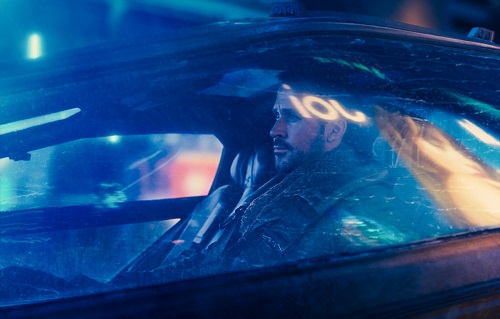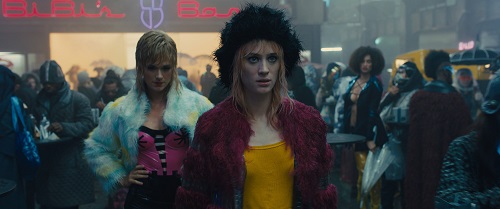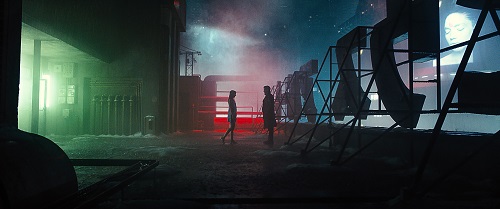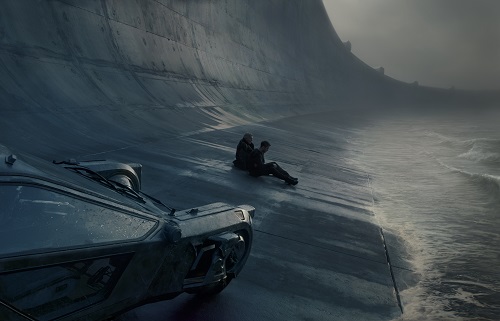Synopsis: A young blade runner’s discovery of a long-buried secret leads him to track down former blade runner Rick Deckard, who’s been missing for thirty years.
Release Date: October 6, 2017 MPAA Rating: PG-13
Genre(s): Sci-Fi, Thriller
Film Review

Production
Released in 1982 and based on a Philip K. Dick novel, the original Blade Runner is a cult science fiction classic. Rumors of a sequel have been circulating for years, and now, it’s finally here. And for the most part, Blade Runner 2049 lives up to the hype.
Set thirty years after the events of Blade Runner, Blade Runner 2049 is about an assassin, or Blade Runner, named K (La La Land‘s Ryan Gosling) who tracks down artificial androids called replicants who have rebelled against their human creators. Over the course of his duties, K unearths a secret that can change everything about the pecking order of the world. His discovery sends him on a search for a long lost Blade Runner named Rick Deckard (played by Star Wars: The Force Awakens‘ Harrison Ford in the first movie), but K is not the only one looking for the mythological recluse.

Written by Hampton Fancher (the subject of the documentary Escapes who also wrote the first Blade Runner) and Michael Green (Alien: Covenant, Logan), the screenplay for Blade Runner 2049 is full of twists, turns, and surprises, so it’s best to go in with as little knowledge of the actual story as possible for full enjoyment. Director Denis Villeneuve (Arrival, Enemy) puts his stamp on the narrative, bridging the gap between Ridley Scott’s iconic film and the current one in a way that honors the original while still allowing it to showcase his own storytelling style.
The two-hour-and-forty-three-minute running time of Blade Runner 2049 sounds daunting, but the movie actually flies by. It’s a very wordy film, with plenty of philosophizing and existentialising coming from both humans and replicants (and, in true Blade Runner fashion, it’s not always clear which is which). The slight action is just enough to break up the monotonous monologues, and the pacing of Blade Runner 2049 is anything but glacial. It’s a quick almost-three-hours.

Blade Runner 2049 doesn’t have all of the same high-tech neo-noir of its predecessor, but it’s close, and fans of the original won’t be disappointed. The problem is that the original is a “cult” film, with just as many detractors as fans, and Blade Runner 2049 will have detractors as well. But no one can deny that it’s a technically beautiful movie that accomplishes most of its cinematic goals.

Cinematography
Cinematographer Roger Deakins (Sicario, Unbroken, Prisoners) is the perennial bridesmaid with thirteen Academy Awards nominations yet no wins. The last three years, he’s been one-upped by Emmanuel Lubezki (The Revenant, Birdman, Gravity). Well, his work on Blade Runner 2049 should net him his first win. Blade Runner 2049 is beautifully shot. Deakins pulls out all the stops, using wide-angle lenses, select focus, diopter shots, and other similar tricks that give Blade Runner 2049 a wholly unique look. The color palette shifts between being bathed in neon lights and swathed in shadowy rain, paying tribute to the look of the original film without blatantly ripping it off. Some of the imagery is aided by the technology of visual effects (including the best love scene of the year), but even the holograms and laser beams are just added paint on Deakins’ canvas. Deakins’ photography in Blade Runner 2049 is both stunning and spellbinding, and provided there are no huge revelatory releases for the rest of the year, we’ll be hearing Deakins’ name come Oscar time – as far as cinematography goes, Blade Runner 2049 should be able to beat Terrence Malick’s Song to Song, which is Lubezki’s 2017 offering.


Sound
The sound design in Blade Runner 2049 was expertly crafted by Theo Green (House at the End of the Street, The Gambler). Of course, it’s a science fiction movie, so there are plenty of bleeps and bloops and such, but the main draw to the sound is the immersive experience of it. Green makes great use of the Dolby Atmos surround technology to put the viewer right in the middle of the movie; the audience is so surrounded by the rain that it almost feels the wetness and smells the damp. And Green understands how to use frequency and amplitude (pitch and volume) in a way that rattles the seats without deafening the audience, something that the equally immersive Dunkirk does not get right. There’s also a suitably sci-fi score by Hans Zimmer and Benjamin Wallfisch (who also worked together on Batman v Superman: Dawn of Justice) which blends in perfectly with the sound effects track to make one epic soundscape.

Cast and Crew
- Director(s): Denis Villeneuve
- Producer(s): Broderick JohnsonAndrew A. KosoveSynthia Sikes YorkinBud Yorkin
- Screenwriter(s): Hampton FancherMichael Green
- Story: Philip K. Dick
- Cast: Ryan Gosling (‘K’)Robin Wright (Lieutenant Joshi)Ana de Armas (Joi) Sylvia Hoeks (Luv)Mackenzie Davis (Mariette)Dave Bautista (Sapper Morton)Carla Juri (Dr. Ana Stelline)Edward James Olmos (Gaff)Hiam Abbass (Freysa)Wood Harris (Nandez)David Dastmalchian (Coco)Harrison Ford (Rick Deckard)
- Editor(s): Joe Walker
- Cinematographer: Roger Deakins
- Production Designer(s):
- Costume Designer: Renée April
- Casting Director(s): Zsolt CsutakFrancine MaislerLucinda Syson
- Music Score: Hans Zimmer & Benjamin Wallfisch
- Music Performed By:
- Country Of Origin: USAUK
